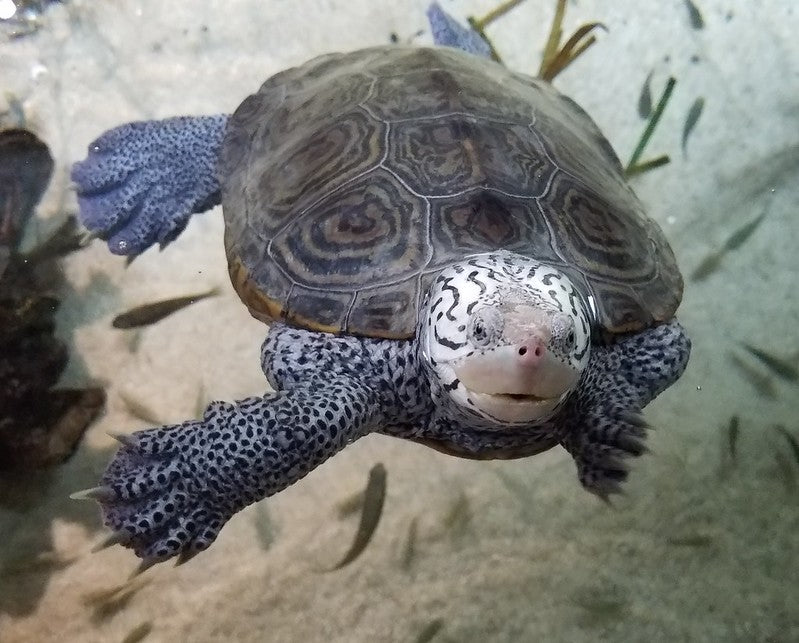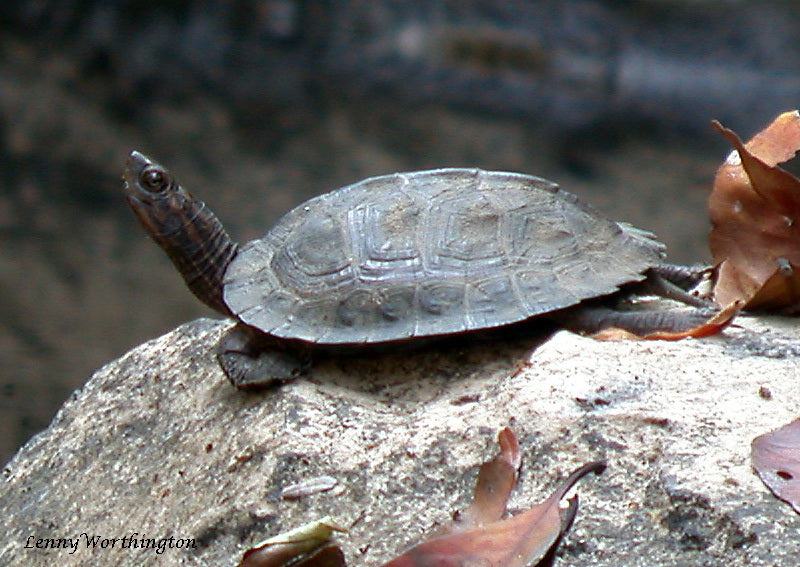Diamondback terrapins (Malaclemys terrapin) are medium-sized, semi-aquatic, diurnal reptiles native to the coastal southeastern United States. They can be found in saltwater habitats such as reedy marshes, tidal flats, estuaries, brackish channels, and other types of coastal wetland.
Diamondback terrapins grow up to 5-9” long depending on sex, with males being smaller (5-6”) and females being significantly larger (up to 9”). The shell is smooth and oval with a subtle dorsal keel, feet are large and webbed, the head is large, and nostrils are located at the very tip of the snout. Color and patterning vary significantly by locality, but typical appearance is gray skin with lots of small black spots and squiggles, patternless “lips” around the beak, and dark concentric rings on the scutes. Plastron may be patterned or patternless. Although most diamondback terrapins have a grayscale color scheme, some localities have orange markings and/or a yellow-orange shell/plastron.
Diamondback terrapins are generally laid-back and can make good pets, particularly the smaller males. But they still have very specific water chemistry needs, as well as relatively high maintenance requirements. But when you’ve dedicated yourself to caring for this stunning pet properly, they can live up to 40 years.
Note: Diamondback terrapins may be very common in the US, but that is not a reason to take one from the wild! If you want a pet diamondback terrapin, purchase one from a reputable breeder.
How much space do diamondback terrapins need?
Diamondback terrapins are amphibious and fairly active, so they need an enclosure that will appropriately accommodate their preferred lifestyle. The enclosure should be large enough to provide at least 10 gallons of water per inch of the turtle’s expected adult length, which means you will need at least 60 gallons of water for a male or 90 gallons for a female. Although an aquarium can be adapted for the purpose, a Waterland tub is the best style of enclosure for this species. This species is a strong swimmer, so deep water is not a problem.
Diamondback terrapins tend to do best when housed outdoors where local climate permits, even if it’s just during part of the year. Depending on where you live, and how you’ve set up your pond, it may even be safe for them to stay outside through the winter. Outdoor housing is a convenient way to provide your turtle with plenty of space and “free” heating and lighting, but make sure the enclosure is well secured against both escape and potential predators.
It is best practice not to house multiple diamondback terrapins in the same enclosure, as they turn aggressive in crowded conditions. However, if you can provide extra basking space and at least 30 extra gallons of water per extra turtle, particularly in an outdoor pond, cohabitation becomes more feasible.
Do diamondback terrapins need UVB?
Diamondback terrapins require regular exposure to high-quality UVB in order to maintain optimal health and wellbeing. Providing UVB lighting to your turtle gives them all of the vitamin D that their body needs, stimulates better appetite and activity, and strengthens the immune system, as well as other benefits.
The best UVB bulbs for diamondback terrapins are:
- Zoo Med Reptisun T5 HO 5.0
- Arcadia Forest 6%
The UVB bulb should be half the length of the enclosure and housed in a reflective fixture like the Arcadia ProT5 or Vivarium Electronics. Place the lamp close to the heat lamps, about 13-14” above the basking platform if there’s no mesh obstruction, but 8-11” away if there is mesh. UVB bulbs decay over time, so don’t forget to replace your bulb every 12 months to maintain good performance.
It’s also a good idea to provide a strong LED or T5 HO 6500K daylight lamp for additional illumination. This helps better replicate daylight and is also good for any live plants you may be using.
Lights should be on for 14 hours/day during summer and 10 hours/day during winter. If you are housing your turtle outdoors in an appropriate climate, supplementary lighting is not required.
What basking temperatures do diamondback terrapins need?
Diamondback terrapins are ectotherms, which means that they rely on the variable temperatures of their environment to help regulate their metabolism and stay healthy. Here’s the range of temperatures a diamondback terrapin’s indoor enclosure should offer:
- Basking: 90°F
- Water: 76-78°F
Measure basking temperature with a digital probe thermometer, and water temperature with a high-quality aquarium thermometer.
A good way to warm the basking area is with a couple of halogen flood heat lamps clustered on one side of the enclosure and positioned over a sturdy basking branch or rock. Do not use ceramic heat emitters (CHEs), red bulbs, or blue bulbs, as these are not as effective. Increase the wattage if they’re too cool, and use a plug-in lamp dimmer if they’re too warm.
If you need to heat the water, use a high-quality aquarium heater rated for at least the maximum volume of water in the enclosure.
If you are housing your turtle outdoors, supplementary heating should not be required. However, they will need to be brought indoors for the winter once temperatures in your area get below 50°F at night.
What water conditions do diamondback terrapins need?
Diamondback terrapins are semi-aquatic, which means that most of the enclosure should be water. Furthermore, they are native to a brackish environment, which means you will need to pay close attention to water pH and salinity. This water must be kept clean at all times in order to keep your turtle healthy (and to keep the aquarium attractive). The most efficient way to do this is with a combination of excellent filtration, regular water changes, and chemical balancing.
Aquatic turtles are fairly messy creatures, so you will need a canister-style filter capable of handling at least 2-3x the amount of water in the enclosure. So, if you have an aquarium or pond with 90 gallons of water, you will need a canister filter rated for at least 180 gallons of water. Don’t settle for the cheapest filter you can find — this is one aspect of your turtle’s enclosure not to skimp on!
Once every 1-2 weeks, remove and replace approximately 30% of the aquarium/pond’s total water volume. This helps minimize buildup of toxic compounds in the water that a filter is unable to resolve. To make the job easier, use a siphon or water pump.
At least once a week, check the water’s pH and salinity. Captive-bred diamondback terrapins can potentially survive being kept in freshwater, but they’re more likely to stay healthy with a more acidic and salt environment. Aim for a pH of 6.8-7.0 and a specific gravity of 1.014-1.018. Use rock salt to increase salinity and fresh water to decrease it. pH can be increased with fresh water and decreased with tannin solution or the addition of tannin-producing organics like mopani wood, birch cone, alder cones, catappa leaves/bark, or coconut husk.
Both indoor and outdoor turtle ponds require filtration, water changes, and chemical balancing.
What substrate is good for diamondback terrapins?
If you are using a Waterland tub or similar setup, the land portion of the enclosure should offer several inches of moistened sand. You can do this with play sand or fine white quartz sand such as Zoo Med ReptiSand or Exo Terra Desert Sand, but best practice for this species is to use crushed coral.
Substrate is not required in the aquatic portion of the enclosure, although it does offer a form of enrichment when provided, encouraging natural behaviors. Sand and crushed coral are the best options here as well. This must be cleaned with a siphon regularly, preferably at each water change. Avoid pebbles or gravel.
What décor can you use in a diamondback terrapin pond?
The most essential piece of “décor” you will need in your turtle’s enclosure is going to be a basking platform. Ideally, this should be a partitioned-off area of land where the turtle can climb out of the water, bask, and explore a bit. If that is not possible, securely stacked rocks, a large piece of wood, or a commercially-available turtle basking platform can be used as a basking location. The turtle should be able to easily climb onto the platform, and it must be large enough for the turtle to remove its entire body from the water and walk around a bit.
Aside from the basking area, there are additional ways you can increase the enclosure’s functionality and general attractiveness. Here are some ideas:
- live/artificial plants
- mopani wood
- hollow logs
Make sure your turtle has access to places where it can hide from view as needed. Hollow underwater hiding areas should be large enough that the turtle can’t get stuck, as this can lead to drowning!
What do diamondback terrapins eat?
Diamondback terrapins are carnivores, which means that they need to eat an animal-based diet in order to get the nutrition that they need. Juveniles should be fed daily, as much as they can eat in 15 minutes. Adults should be fed every other day with pellets or prey.
A portion of food should be roughly the same size as the turtle’s head. Diamondback terrapins are not good at chasing down fish, so fish prey should be pre-killed and frozen for at least 48 hours before thawing and offering to the turtle.
Animal-based foods for diamondback terrapins: shrimp, brine shrimp, krill, clams, mussels, snails, crayfish, small crabs, earthworms, American roaches, crickets, dubias, discoids, grasshoppers, guppies, mollies, platies, mosquito fish
Pellets for diamondback terrapins: Omega One Juvenile Turtle Pellets, Omega One Adult Turtle Sticks, Tetra ReptoMin, Zoo Med Natural Aquatic Turtle Food, Mazuri Aquatic Turtle Diet
Supplements
Including commercial pellets in your turtle’s rotation is the best way to make sure your pet is getting enough vitamins in their diet, particularly vitamin E. For extra calcium, however, your turtle needs access to a cuttlebone or calcium block at all times.
Drinking Water
Believe it or not, even though diamondback terrapins live in a semiaquatic environment, because the water is brackish, they need occasional access to fresh water in order to fully hydrate. In the wild, they “stock up” on fresh water when it rains. In captivity, it’s best to soak your turtle in a plastic tub with an inch or two of fresh water (no deeper than standing depth) 1x/week.
Do diamondback terrapins like to be handled?
As a general rule, turtles do not like to be handled. Keep handling to a minimum unless it is absolutely necessary for inspection or transportation (ex: going to the vet for a checkup). If you would like to interact with your turtle, try hand-feeding it with a pair of feeding tongs.
*This care sheet contains only very basic information. Although it’s a good introduction, please do further research with high-quality sources to obtain additional information on caring for this species.
"Malaclemys terrapin (Diamondback Terrapin)" by JW Shultz is licensed under CC BY 2.0.



Leave a comment
This site is protected by hCaptcha and the hCaptcha Privacy Policy and Terms of Service apply.